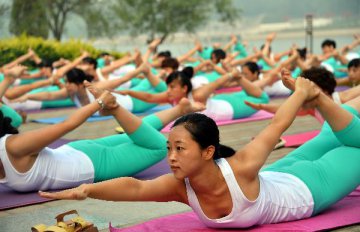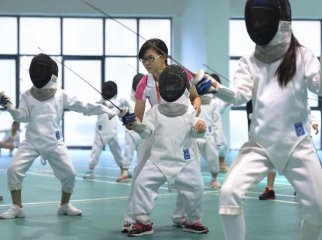
China's sports industry is expected to account for 0.7 percent of the GDP with an added value of 400 billion yuan (about 62 billion U.S. dollars) in 2015, which are the highest figures so far in its development and basically meet the goal set by the 12th "Five-Year Plan".
This was disclosed earlier this month by Feng Jianzhong, deputy director of the State General Administration of Sport of China. Feng attributed the achievement to government support, huge capital input from all sectors, and enthusiasm among the public to participate in sports.
COMPARISON AND CONTRAST
Although China's sports industry has grown by leaps and bounds, it is, compared with those of the developed countries, still in its infancy and requires nutrients. Up to 2014, the total value of China's sports industry was 320 billion yuan (about 50 billion dollars), accounting for 0.6 percent of the GDP, while in the United States, the ratio was around 3 percent. And some other developed countries had also surpassed 1 percent years ago.
The shinning point is that China has become the world's largest sports goods manufacturer, and some products are named after world champions, for example the "gymnastic prince" Li Ning. But the brand value is still not as competitive as Nike or Adidas. And manufacturing is not the most profitable sector in the sport industry. The sports entertainment business plays a leading role in the sports industry, stimulating the development of related sectors, such as sports sponsorship, TV relay, sports media, sports advertising, sports lottery and etc.. In these areas, China is still lagging far behind.
In other words, falling behind could mean great potential. The Chinese economy has been growing fast for the past three decades and has become the largest in the world by some measures. There is no concrete excuse for the sports industry to make such a little contribution. In a sense, China's sports industry is a "gold mine" which has not been fully tapped.
RETROSPECTION
In retrospect, sports were run by the government in the era of planned economy. The strengths of such a system are evident in yielding gold medals, which reached the peak in 2008 when host China topped the tally with 51 gold medals at the Beijing Summer Olympics. But the system makes it harder for the market to grow. In the past three decades, many Chinese industries have embraced marketization and globalization.
But the sports industry did not catch up with the trend. Although in 1994, China brought in the professional league system for its football as a test for sports reform, few Chinese people regards the test as a successful one. Chinese people often ask why a global economic and sports powerhouse has singularly failed at playing the global game.
One poor FIFA World Cup appearance in 2002 aside, China has made no perceptible impact on the world's most favorite sport. Beset by corruption and poor management, Chinese football has continuously provided laughing stock. Things must be changed and have started to change, indeed.
The turning point came in 2010 when China's State Council, for the first time, issued a Guiding Opinion designed to boost the development of the sports industry and to elevate it to an unprecedented strategic position.
The Guiding Opinion pointed out that private investment in China's sports industry is actively encouraged, and market exploration of sports performance and recreational sports should be put into action to a greater extent. However, the timely rain was just a guide without specific and practical details. The breakthrough point came in 2014.
AMBITIOUS PLAN
China mapped out the plan of speeding up its sports industry on Oct. 20, 2014 when the State Council announced a guideline, named Opinions on Accelerating the Development of Sports Industry and Promoting Sports Consumption.
According to the guideline which set the year 2025 as the deadline, the value of the overall scale of the sports industry is expected to reach 5 trillion yuan (about 800 billion dollars), the average sports venue area per person will reach 2 square meters, the number of people who regularly participate in sports activities will reach 500 million, and the coverage of new neighborhoods with sports facilities will reach 100 percent.
In a bid to encourage social investment, the guideline said that the government-identified high-tech sports companies will have their corporate income tax reduced from 25 percent to 15 percent and that the identified companies engaging cultural and sports activities will have their operation tax reduced to 3 percent. Analysts said that the ambitious plan, based on the current conditions, is not a castle in the sky.
THREE ADVANTAGES
First, from the year 2008, the average GDP per capita for Chinese people had reached beyond 3,000 dollars, and the figure in 2014 was around 6,700 dollars, which indicated that people are capable of spending more money on sports.
Second, China's 1.4 billion population is also a strength. Third, the attention and support from the central government is also a key factor. The government has broken down the industrial and policy barriers, such as axing administrative approval procedures and opening to the public all fields that are compliant with existing laws and regulations. It also welcomes private and foreign capital investment in the sports industry.
BIG CAKE
Football ranks first among all sports internationally, making up more than 40 percent of profits in the entire sports industry. In a sense, if the football market keeps blighted, China can hardly fulfil its dream of prospering the sports industry. Since the ambitious plan issued by the State Council in 2014, Chinese billionaires responded with quick actions and their hands were put firstly to football.
Ma Yun, the owner of Chinese e-commerce giant Alibaba, paid 1.2 billion yuan (about 192 million dollars) for 50 percent stake in Guangzhou Evergrande, the five-time Chinese Super League champion and two-time AFC Champions League winner.
Alibaba, the Nasdaq-listed company which have business cooperations with German champions Bayern Munich, Spanish giants Real Madrid and NBA star Kobe Bryant, also launched its own sports company in September.
Two other Chinese internet giants LeTV and Tencent have established respective sports companies as well. Wang Jianlin, owner of China's leading conglomerate Dalian Wanda, even flexed his might in international football. In January, Wanda paid 25 million euros for 20 percent stake in Spanish champion Atletico Madrid.
In February, Wanda acquired Swiss sports marketing company Infront Sports & Media in a deal valued at about 1.2 billion dollars. Wanda, founded in 1988 and known for its real estate success, once owned China's top professional football team Dalian Wanda but sold the club in 2000 over disillusionment with a league rife with corruption and scandals.
Wang Jianlin is no doubt the most experienced football investor among the Chinese billionaires. In a bid to raise the level of Chinese football, he has provided financial aid to more than 100 Chinese teenagers for advanced training in Spain.
Wang also admitted that the purchase of Infront might help China's potential bid for a World Cup. "Infront's rich and valuable resources in football might help China eventually realize the dreams of qualifying for a World Cup again, hosting a World Cup and winning a World Cup," said Wang. In March, China's central reform group, captained by President Xi Jinping, approved a plan to revive Chinese football.
"We must develop and revitalize football to ensure we are a strong nation of sports," said an statement from the group. In April, Chinese media group Ti'ao Power acquired the copyrights of the Chinese national football teams at the price of 70 million yuan (about 11 million dollars) a year.
But the most thrilling story came in September when Ti'ao Power won the bid for the producing and broadcasting rights of the Chinese Super League (CSL) games for the next five seasons at a price of 8 billion yuan (about 1.25 billion dollars). In 2013, the CSL earned only 370 million yuan (about 60 million dollars) from sales of broadcasting rights and sponsorship.
It is believed that all CSL teams will benefit from the huge investment. With strong financial backing, Guangzhou Evergrande has signed up Brazil star coach Luiz Felipe Scolari, and Shandong Luneng, another Chinese Super League giant, acquired another former Brazilian national team coach Mano Menezes.
A group of foreign footballers, mainly from Brazil, have been lured to the Chinese Super League as well. In November, China toymaker Rastar Group paid 78 euros a share in cash for 56 percent stake in Spanish first division club Espanyol.
The move showed the increased interest of Chinese companies in Spanish football with Rayo Vallecano and Real Sociedad both being sponsored by Chinese company Q-Bao.
BRIGHT FUTURE
As China's sports industry further expands, it will become more and more attractive to domestic and foreign investors. Statistics show that China's sports industry accounted for 0.5 percent of the GDP in 2008. It took six years for China to raise the figure to 0.6 and only one year to 0.7. As the portal to the "gold mine" is unlocked, China's sports industry is on a high-speed train and it strikes a win-win for both China and abroad.






















Latest comments